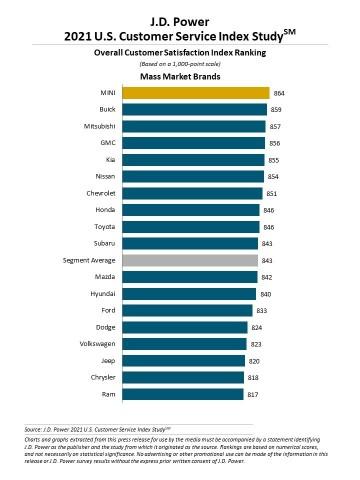J.D. Power found that auto dealer service departments deal with difficult situations
Even with the pandemic and fewer people driving, the number of visits to dealer services in the U.S. has dropped by only 6% over the previous year, and overall satisfaction has increased from 837 to 847 per year (in 1,000 Prior to this, according to the JD Power 2021 Customer Service Index (CSI) research. Overall satisfaction has also improved for the sixth consecutive year.
“When one- to three-year-old vehicles required service in 2020, dealers captured an even greater share of service visits, which is the highest level in at least five years,” said Chris Sutton, vice-president of automotive retail at J.D. Power. “Dealerships made the most out of a disruptively bad situation.
“Completing work right the first time, as well as focusing on customers’ needs, play significant roles in satisfaction—and dealers are nailing these key performance indicators nearly 100 per cent of the time. By continuing to provide an exceptional service experience, dealers have an opportunity to seize an even greater share of the market. It’s notable, too, that while service was less frequent in 2020, customers responded very well to convenience services such as vehicle pick-up and drop-off at their home.”

The study measures satisfaction with service at a franchised dealer or independent service facility for maintenance or repair work among owners and lessees of one- to three-year-old vehicles. It also provides a numerical index ranking of the highest-performing automotive brands sold in the United States, which is based on the combined scores of five different measures that comprise the vehicle owner service experience. These measures are (in order of importance) service quality (29 per cent); service facility (19 per cent); service initiation (18 per cent); service advisor (18 per cent); and vehicle pick-up (16 per cent).
Following are key findings of the 2021 study:
Remote or online payment options boost satisfaction: While service customers didn’t frequently use contactless payment options—only six per cent of premium and one per cent of mass market owners say they used these methods—pick-up satisfaction is highest among those who used these options. Satisfaction scores improve 44 points among premium customers who pay remotely or online compared with handling payment via a cashier. Among mass market customers, satisfaction improves 69 points. “This is an example of a process some dealers may have put into place as a safety measure during the pandemic, but which they may want to keep in place, as customers find they like it more,” Sutton said.
Using express service increases satisfaction: Satisfaction among customers who did not use express service for maintenance is flat compared with a year ago. However, satisfaction among those who did use express service has increased 10 points during the pandemic.
Battery-electric vehicle owners less satisfied with service: According to the J.D. Power 2021 Electric Vehicle Experience (EVX) Ownership Study, only 54 per cent of battery electric vehicle (BEV) owners indicate they had taken their vehicle in for service in the past 12 months. However, the 2021 CSI Study finds that when they do visit a dealer for service, their overall service satisfaction is 69 points lower than the average customer and 76 points lower for service quality. “BEV owners present a unique challenge for dealers,” Sutton said. “Not only are their vehicles more difficult to service than traditional internal combustion engine vehicles, but also the lower frequency of visits means dealers have fewer chances to make a positive impression on these customers.
BEV owners are less satisfied with maintenance than repair: On average, maintenance work completed during a dealer service visit is almost twice as much as repair work. However, the repair to repair ratio for BEV owners is almost evenly divided. Although more complex service repair work usually results in lower customer satisfaction Maintenance work, but for BEV owners, the situation is just the opposite. An important reason for this is that BEV owners are 2.5 times more likely to fail to complete the service correctly the first time. The dealer seems to be providing maintenance services for these vehicles," Sutton said. "Automakers may want to invest in more dealer service training. Otherwise, they will face the risk of losing repeat customers. "
-
Latest
 First drive: 2010 Bentley Continental GTC Speed
First drive: 2010 Bentley Continental GTC SpeedFew cars can truly shock and awe the onlookers. Of course, Ferrari and Lamborghini make people's hearts beat faster, but there is another market segment that does make people stare and envy those who...
-
Next
 2021 Ford Bronco overview: G.O.A.T will challenge the Jeep after a 25-year hiatus
2021 Ford Bronco overview: G.O.A.T will challenge the Jeep after a 25-year hiatusThe Ford Mustang is finally here in 2021. I have been waiting for a long time. Ford first produced it in 1966 to directly compete with the Jeep CJ-5, and in 1996 stopped producing the fifth-generation...
Popular Articles
- Car buyers willing to redouble their efforts to buy a car
- Hyundai Canada announces adjustment of its marketing department
- Mercedes-Benz Canada announces comprehensive Mercedes-EQ charging strategy
- GM extends OnStar automotive insights to non-GM
- Kia Canada enhances buyer knowledge at new electric vehicle experience center in Vancouver
- Mitsubishi Motors launches digital showroom
